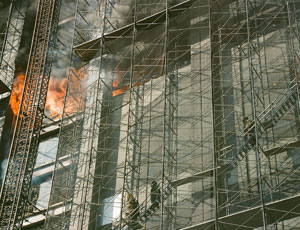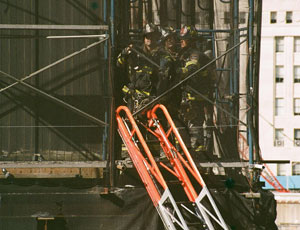As the first month of testimony ended April 29, New York Fire Dept. witnesses in the manslaughter trial of three construction managers in the 2007 Deutsche Bank fire in Manhattan painstakingly narrated the role of site conditions, particularly a dismantled standpipe, in the disaster that killed firefighters Robert Beddia and Joseph P. Graffagnino.


The slow pace of testimony so far in the trial, which opened April 4, caused State Supreme Court Judge Rena K. Uviller to order prosecutors on May 2 to speed up the proceedings.
She is deciding the outcome for one defendant, Mitchel Alvo, an asbestos abatement supervisor for demolition subcontractor John Galt Corp. and for the firm itself.
The other defendants, Jeffrey Melofchik, former building safety manager for general contractor Bovis Lend Lease, New York City, and Salvatore DePaola, another Galt abatement supervisor, opted for a jury decision.
The three men are charged with manslaughter and criminally negligent homicide in the firefighters’ deaths.
Department Lt. Simon Ressner testified that he was called to the scene immediately after the Aug. 18 fire to assess how and why the building’s standpipe system failed to carry water to the 17th floor, where the fire started. The former 40-story high-rise, damaged during the 9/11 terror attack in 2001, was undergoing asbestos abatement and demolition. That work was completed in January.
Ressner, who holds a degree in architectural engineering and worked for several engineering firms before joining the department in 1990, initially provided the jury with a concise primer on systems and pipes typically found in a high-rise office building such as the Deutsche Bank.
As part of their assessment of the fire scene, Ressner and crew members tested the standpipe system, which included isolating it, from the first floor up, to determine whether the system would have delivered water to upper floors at the recommended pressure if it had been engaged on the first floor rather than via the Siamese connections that led to the basement.
“As a backup procedure [in firefighting] we would pump water directly into the riser if the Siamese connection wasn’t working,” Ressner explained. To test the risers, team members simulated conditions for the backup procedure.
“We pumped water from the first or second floor to see if it went up and it did, he added. “[We determined that] the riser was intact and usable and the horizontal sections [of the standpipe] were not usable.”
Much of Ressner’s testimony focused on couplings made for plumbing, heating and cooling system pipes by Victaulic, based in Easton, Pa. “They are a very big money saver because they are quickly assembled and easy to work with; you don’t need special skills,” he said.
Ressner added that they are commonly used in New York City construction, where “the prevailing practice is to do things as inexpensively and quickly as possible.”
Victaulic couplings, many of which are orange-red in color, are very commonly used on fire prevention systems including standpipes and sprinkler lines. Earlier, former construction foreman Alphonso Ortiz had testified that the red color of the couplings on the cut pipe in the basement indicated to him that the pipe was a standpipe.
Ressner’s testimony supported this conclusion. He said that if he saw Victaulic couplings used in a building of “the same vintage and construction” as Deutsche Bank, “my conclusion would be that it’s either a standpipe or a sprinkler.”
Under defense cross-examination, Ressner explained that virtually all high-rise commercial buildings in New York built after 1970, including Deutsche Bank, have Victaulic couplings on their standpipes. “In newer buildings [built in the last ten years], you’re seeing Victaulic couplings on more systems other than fire prevention [such as HVAC],” he noted. But he said in inspecting the high-rise, he did not see Victaulic couplings on any pipes other than those for fire protection.
Diego Marin, an asbestos abatement worker for the John Galt company, testified through a Spanish interpreter for the prosecution. He was a member of the clean-up crew working in sub-basement B on the day that the hangers were cut and the 12- to 15-foot section of standpipe fell to the floor in basement A above them.
Hearing questions through the interpreter and replying in Spanish, Marin testified about the tone of communication between defendants Mitchel Alvo and Salvatore DePaola. The prosecution contends that the interaction between the two was “hostile,” and that faced with the prospect of losing bonuses tied to performance goals, Alvo repeatedly insisted that the work be done faster.

Post a comment to this article
Report Abusive Comment